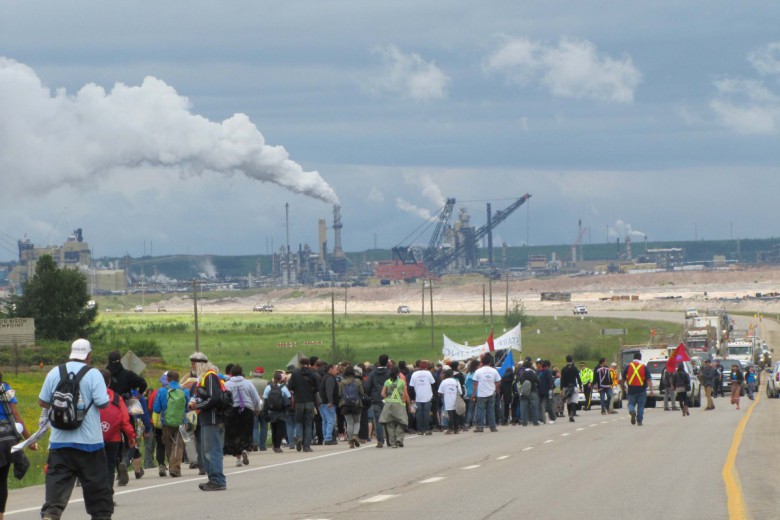In Fort Frances, Ontario, the lights are on at the local mill, but no one is at work. A skeleton crew is maintaining minimal heating to keep the winter from turning the town’s economic centre-piece, which once employed 1,000 workers, into a pile of scrap.
As recently as the end of 2014, there was hope – but barely. “We’re hanging on by our fingernails,” Fort Frances’ mayor, Roy Avis, told the Globe and Mail after a potential deal to sell the mill fell through. The rallies to save Fort Frances have died down, and laid-off mill workers are cobbling together a living in the absence of the town’s economic mainstay.
Statistics show that the scene is a familiar one across Canada. Since 2004, the number of jobs in forestry has dropped from over 300,000 to just over 190,000. Once-thriving rural communities are on the brink of becoming ghost towns.
In some ways, this is by design. International markets for pulp, paper, and lumber follow boom-and-bust cycles. Logging giants rake in profits and hire workers when prices are high, but quickly close down operations when conditions are less favourable.
This capital-intensive, corporate-dominated, and export-oriented model of forestry has reaped billions in profits for the industry, but rural livelihoods and the welfare of forests have often been treated as afterthoughts.
There’s an alternative to this corporate-dominated model of forestry, but it has seldom been tried. It works by significantly reducing the export of commodities like paper, lumber, or even uncut logs, and instead creating value-added products locally – custom-cut beams, log homes, furniture, as well as herbs and mushrooms harvested from forests.
The “log less, work more” framework has largely been passed over in favour of the corporate model, for practical and political reasons. On the practical side, developing markets for value-added products takes time, training, experimentation, and investment. As for politics, the forestry giants have deep pockets and exercise more influence on provincial governments than First Nations, mil workers, or environmentalists. A value-added forestry sector could mean more income overall, but it would also mean fewer concentrated profits for large pools of investment capital.
While environmentalists have traditionally focused on protecting forests by minimizing or preventing logging altogether, the best hope for forest conservation may be the alliances between grassroots environmentalists, First Nations, and forestry workers.
Canada has vast forests, accounting for 9 per cent of the world’s total. Most of these nearly 3.48 million square kilometres are on so-called Crown lands, a name that conveys public ownership of the areas and obscures the fact that they are the traditional territories of Indigenous nations. The government’s role in the forestry sector is complicated: though relations with on-reserve First Nations fall under federal jurisdiction, 90 per cent of the country’s forests are under provincial and territorial jurisdiction (6 per cent are privately owned, and the remaining 4 per cent are governed by the federal government or Indigenous communities). Provincial governments have for decades felt entitled to give the right to exploit Crown lands to forestry and mining corporations, cutting First Nations out of the deal while defying both Canadian and Indigenous laws and agreements.
Attempts to change the way forests are managed focus on who gets the forestry licence. In Fort Frances, the licence to cut trees on Crown land belongs to a company called Resolute Forest Products. Activist and former forestry worker Ananda Lee Tan explains that the licence was granted with the expectation that the company would operate a mill and provide some benefit to the community. When the mill closed, however, the Ontario government was reluctant to modify the underlying licence. But with Resolute controlling the harvest – and more importantly, the price – of nearby forests, buyers were reluctant to buy into an old, struggling mill.
Sara Mainville, chief of the neighbouring Couchiching First Nation between 2014 and February 2016, told the Globe and Mail at the time: “If Resolute refuses or cannot make a business operating the kraft mill, then I think the forest licence shouldn’t stay with Resolute.”
The Ontario NDP joined in with urgent appeals: “With the stroke of a pen, the minister can convert the sustainable forestry licence to an enhanced sustainable forestry licence so that the commun-ity and companies manage that forest together,” provincial NDP leader Andrea Horwath told the legislative assembly on November 4, 2014.
In 2014, as the Ontario government stood pat, the price of paper tumbled to its lowest point since 2010, when it was just recovering from the total collapse of 2008.
Two years later, Mainville doesn’t hold much hope that the mill will reopen. “There’s a transition going on,” Mainville told Briarpatch. “We’re not focusing on pulp and paper anymore – we’re trying to find ways to do more sustainable things with forest products.” The First Nations around Fort Frances are “getting together to talk about how to utilize the forests in a more sustainable way.”
Couchiching has been building its capacity to manage local forests, starting with the Sapawe Forest. When the First Nation took over, Sapawe was badly managed, but the local Anishinaabe have improved things quite a bit.
“We’ve always believed that we should be involved in managing the forests and all our relations in the forest,” said Mainville. “To be frank, I think we can do it better; in the next few years, you’ll see and hear about things that we’re doing.”
But amid apologies and inquiries, the current direction of Canada’s policy remains the same. Dozens of First Nations are still sitting at what Mohawk policy analyst Russ Diabo calls “termination tables”: negotiations that result in the extinguishment of Aboriginal title, the legal rights First Nations hold to their traditional territories.
The major Supreme Court victories by the Tsilhqot’in and Haida, western First Nations that blockaded logging operations and subsequently spent years in court, are putting pressure on governments to negotiate with First Nations. Grassy Narrows, which is party to Treaty 3, was unsuccessful in challenging Ontario’s ability to hand their treaty lands to logging companies.
For Indigenous nations to have both their inherent and treaty rights respected, Diabo told Briarpatch, forest management legislation in provinces across the country would have to be amended. For now, “the burden of proof is on First Nations to prove that they have title, and it costs money to back up the assertion of those rights – you have to go to court.” Major legal battles to enforce the law can take decades and drain coffers, and the outcome is hard to predict.
Indigenous communities are in a difficult position. They face conditions of dire poverty on one side, and expensive, endless, and potentially fruitless court battles on the other. Governments and industry representatives take advantage of this vulnerability, attempting to entice First Nations to co-operate with the status quo by providing forestry licences and contracts that fall well short of the inherent and treaty rights to which they are entitled.
When boom turned to bust in the 1980s, new alliances that offered hope for the “log less” formula took shape across unceded Indigenous lands in British Columbia. Tan recounts that since the advent of tree farm licences in the late 1950s, “timber companies ha[ve] run roughshod over Indigenous peoples’ rights, community rights, and workers’ rights to build an export-based model of forestry.” In the 1980s and ’90s, new trade agreements meant that mills closed while logs were increasingly sold on the international market. The original social contract that bound forest licences with the management of local mills was no longer upheld. At the same time, annual timber harvesting rates soared, far exceeding ecologically sustainable levels and even the cut volumes permitted by the forest ministry.
Rather than participate in negotiations with timber companies exporting trees from their traditional territories – a practice referred to as “talk and log” – Indigenous nations like the St’át’imc, Haida, and Gitxsan set up blockades on logging roads, forcing companies to head to the Canadian courts.
In response to the court injunctions served by the timber companies, some communities “found a way around these legal processes by having different clans set up staggered blockades on different sections of road, corresponding to their traditional territories,” Tan explains. “In doing so, they educated both the courts and their settler neighbours about Aboriginal title, illustrating the historical and stewardship and traditions that continue on Indigenous lands.”
By the 1990s, Indigenous community blockades, public anger at the industry, and a lot of grassroots organizing led to a number of community events and meetings being held to improve the understanding of First Nations’ rights, discuss sustainable forestry, and look at the overlapping interests of Indigenous, worker, and settler communities. This in turn led to the formation of groups like the Tin Wis Coalition and Labour Environmental Alliance Society, and a high degree of alignment between key activists in environmental groups, labour unions, and Indigenous communities.
The idea that communities could create more long-term, local jobs by logging less (and producing more local wood products) gained traction.
Tan was part of the Canadian Reforestation and Environmental Workers’ Society (CREWS), a union of tree planters that he recalls had over 2,000 members at its peak. CREWS represented the rise of a new voice of labour organizing that saw the possibility of shaping not just better working conditions, but more just and equitable relationships as the foundation of a new economy. As one retrospective put it, CREWS had an appreciation that “socio-ecological histories can be created through labour.” CREWS’ organizing platform, notes Tan, included solidarity with First Nations’ land rights, community-controlled forestry, a ban on all pesticides, protection for all intact old-growth forests, and a ban on raw log exports.
Bold ideas were in the air. “What would it look like for communities and workers to take back control of a mill? Have these mills run by workers, owned and operated? There were a fair number of forest and mill workers who were ready to entertain this idea,” said Tan.
After the watershed moment of the ’93 Clayoquot Sound blockades, the deepening of environmental consciousness, and the election of an NDP government, the fledgling Indigenous-labour-environmental alliances pushed for fundamental change, including land tenure reform and local control.
The high-water mark came earlier than many had expected: once in power, the NDP gave in to pressure from the timber companies. “Talking” was invigorated by civil society participation, while “logging” continued apace. However, community-controlled forestry management did take hold in some areas like the West Kootenays, and the recently closed Vernon log sort yard demonstrated that selling quality logs in small quantities locally created more work and revenue than the bulk export of raw logs.
For Tan, deeper cultural schisms were blocking the realization of fundamental change. The holistic approach of seeking local, democratic solutions was more akin to Indigenous struggle than either mainstream conservation or the big forest unions, many of whom remained reactionary when it came to exploring changes to the whole of the forestry system.
“Many union leaders were scared to take on the industry,” said Tan. “But when you’ve been fighting colonialism for hundreds of years, it provides a different perspective.”
CREWS has joined the annals of labour history. But Tan, who has continued to organize communities and grassroots groups, believes that movement alliances belong more to the future than to the past. “Deep down, the values of the labour movement are much more aligned with Indigenous sovereignty than they are with capitalism.”
Like the labour movement, environmental organizations have been slow on the uptake. Despite countless victories by Indigenous communities, environmental NGOs have persisted in excluding First Nations from their campaign strategies. For example, though it predominantly involves Indigenous lands, the 2010 Canadian Boreal Forest Agreement was negotiated in secret, without any First Nations present.
The huge influx of funding for Canadian environmental campaigns in the 1990s clearly played a role. A number of funders pushed for agreements between conservationists, forestry companies, and occasionally First Nations. This has since often resulted in funder-driven agendas that seek negotiated agreements and compromise with extractive industries rather than striving for new economic models to replace them.
While both labour and environmental groups have nascent relationships with First Nations and Indigenous activists, a strategic alignment in support of Indigenous sovereignty and land rights is still a work in progress.
In towns like Fort Frances, it’s clear that First Nations are crucial to developing sustainable forestry and good jobs. The combination of constitutional clout and multi-generational commitment to the land means that Indigenous nations are best placed to lead the transformation of the ways in which the country’s vast forests are managed.
Couchiching First Nation recently signed an agreement with Confederation College to provide training in forestry trades. At the same time, the First Nation is exploring new ways to create jobs within a framework that cares for the land.
“Our Anishinaabe value system would be part of that management,” Mainville explains. “We’ve always been trying to keep the business decisions as business decisions, but we have relations in those forests. We have to worry about habitat protection – there has been a lot of lip service, but there’s been a lot of loss.”
The new plans will become viable if Couchiching First Nation can gain some measure of control over what happens on the larger part of their lands. “It’s all Treaty 3 territory,” says Mainville. “We’ve always held jurisdiction.”
Who will benefit from the next boom, or from the forest-based industries of the future? Will the land continue to be doled out by legislators in distant provincial capitals to opportunistic corporations that provide jobs during economic upturns and close up shop after the bust?
The question, of course, is how soon governments align with what courts and royal commissions have been saying for years. The courts will continue to hand down decisions, but the real work will be a change in political priorities. The ways in which environmental and labour groups orient themselves in the future will be a key factor in how things play out.
The health of the forests lies with the Nations who have cared for them for thousands of years. The movements that can transform our relationship to the land and to each other must form the right alliances and learn from the past to create the future.







